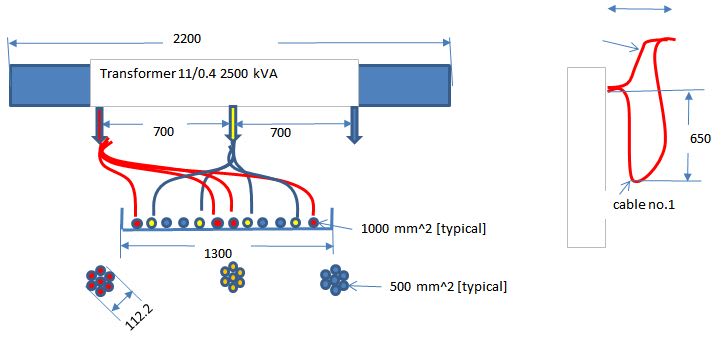PrebenJakobsen
Electrical
Hi Engineers
I have a 11/0.4kV 2500kVA trafo where I need 7 parallel single core cables to carry the current.
Ideal installation is 7 bunches of trefoil cables of equal length, installation conditions etc.
But the distance to LV swbd is only 5m and the phase sequence is opposite, so this requirement is very hard to fulfil.
I am therefore considering to have all L1 on one cable tray, L2 on another and L3 on a third.
In that way I am able to have almost same length of all cables, but the X value is out of control.
Is there any way to evaluate how the sharing between the 7 parallel cables of each phase will be?
Is it possible to look at the transformer + cable impedance to evaluate the sharing?
What would you prefer
- 21 cables of same length but with all L1 on one tray, L2 on another and L3 on a third
- 21 cables in 7 times trefoil but with a length variation of 30% or more
PS: When phase location is solved I will ask about the neutral.
PPS: I would like to avoid modifying the equipment to accommodate a busbar system
Best Regards
Preben Jakobsen
I have a 11/0.4kV 2500kVA trafo where I need 7 parallel single core cables to carry the current.
Ideal installation is 7 bunches of trefoil cables of equal length, installation conditions etc.
But the distance to LV swbd is only 5m and the phase sequence is opposite, so this requirement is very hard to fulfil.
I am therefore considering to have all L1 on one cable tray, L2 on another and L3 on a third.
In that way I am able to have almost same length of all cables, but the X value is out of control.
Is there any way to evaluate how the sharing between the 7 parallel cables of each phase will be?
Is it possible to look at the transformer + cable impedance to evaluate the sharing?
What would you prefer
- 21 cables of same length but with all L1 on one tray, L2 on another and L3 on a third
- 21 cables in 7 times trefoil but with a length variation of 30% or more
PS: When phase location is solved I will ask about the neutral.
PPS: I would like to avoid modifying the equipment to accommodate a busbar system
Best Regards
Preben Jakobsen


![[blush] [blush] [blush]](/data/assets/smilies/blush.gif) :
: